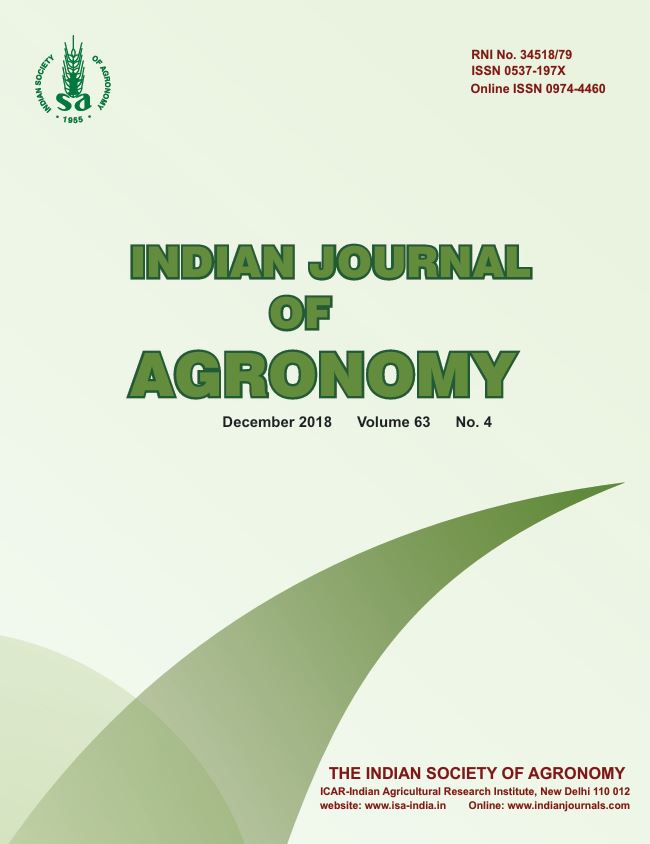Yield and physiological response of newly released rice (Oryza sativa) varieties to crop establishment methods under temperate conditions of Kashmir
DOI:
https://doi.org/10.59797/ija.v63i4.5675Keywords:
Crop-establishment methods, Direct seeded rice, Leaf-area index, Physiological parameters, System of rice intensificationAbstract
A field experiment was undertaken during rainy (kharif) season of 2015 and 2016 to assess the effect of crop establishment methods, viz. system of rice intensification (SRI), direct seeded rice (DSR), recommended method (RM) and farmers’ practice (FP) on the performance of 4 newly released high yielding rice (Oryza sativa L.) varieties, viz. ‘SR-1’, ‘SR-2’, ‘SR-3’ and ‘Jhelum’. SRI method significantly improved growth parameters (plant height, tiller-number, leaf-area index, light interception, root dry weight and root volume), physiological parameters (photosynthetic rate and transpiration rate) and nutrient (NPK) uptake of all the varieties. The average increase in grain yield in SRI, DSR and RM was 22%, 14% and 6.0% over FP, respectively. Among the varieties, ‘SR-1’ and ‘SR-2’ produced 9.5% and 16.8% higher grain yield over ‘Jhelum’, which was at par with ‘SR-3’. However, the highest net returns and benefit: cost ratio was recorded in DSR and ‘SR-2’ rice variety.
References
Arnon, D.I. 1949. Copper enzymes in isolated chloroplasts. Polyphenoloxidase in Beta vulgaris. Plant Physiology 24(1): 1–15.
Hidayati, N., Triadiati and Anas, I. 2016. Photosynthesis and transpiration rates of rice cultivated under the system of rice intensification and the effects on growth and yield. HAYATI Journal of Biosciences 23(2): 67–72.
Hosain, T., Hossain, E., Nizam, R., Fazle, B. ASM and Chakraborty, R. 2018. Response of physiological characteristics and productivity of hybrid rice varieties under system of rice intensification (SRI) over the traditional cultivation. International Journal of Plant Biology & Research 6(2): 1–10.
Kassam, A., Stoop, W. and Uphoff, N. 2011. Review of SRI modifications in rice crop and water management and research issues for making further improvements in agricultural and water productivity. Paddy and Water Environment 9(1): 163–180.
Porra, R.J.W., Schafer, W., Cmiel, E., Katheder, I. and Scheer, H. 1993. Derivation of the formyl group oxygen of chlorophyll b from molecular oxygen in greening leaves of a higher plant (Zea mays). FEBS Letters 323: 31–34.
Priyanka, S., Singh Y.V., Singh K.K. and Shivay Y.S. 2012. Relative efficiency of methods of crop establishment in rice (Oryza sativa). Indian Journal of Agronomy 57(3): 291–293.
Rozen, N., Gustian, G., Jamil, A.J. and Dermawan. A. A. 2018. Response of two rice varieties grown using SRI method in two different locations. JERAMI (Indonesian Journal of Crop Science) 1(1): 39-45.
Singh, D.K., Pandey, P.C., Naiyar, A. and Shilpi. G. 2015. Stand establishment techniques of rice in conjunction with nutrient sources for soil health and productivity of rice (Oryza sativa)–wheat (Triticum aestivum) cropping system Indian Journal of Agronomy 60(1): 31–37.
Thakur, A.K., Uphoff, N. and Antony, E. 2009. An assessment of physiological effects of system of rice intensification (SRI) practices compared with recommended rice cultivation practices in India. Experimental Agriculture 46(1): 77–98.
WWF-ICRISAT Project 2010. More rice for people, more water for the planet. Africare, Oxfam America, WWF-ICRISAT Project, Hyderabad, India pp. 1–35.
Yoshida S. 1981. Fundamentals of Rice Crop Science. International Rice Research Institute, Manila, Philippines.






